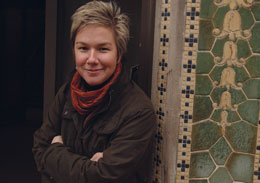 Freelance photographer and former Louisville Magazine intern Karen Ballard was in a New York hotel suite waiting to be introduced to the man in the ball cap standing in the center of the room. Extending his hand, he said, "Ms. Ballard, I really like your pictures."
Freelance photographer and former Louisville Magazine intern Karen Ballard was in a New York hotel suite waiting to be introduced to the man in the ball cap standing in the center of the room. Extending his hand, he said, "Ms. Ballard, I really like your pictures."
"It was Steven freakin’ Spielberg!" Ballard screamed while recounting the moment she was tapped to be location photographer for his political thriller Munich, which dramatizes the aftermath of the 1972 Olympic terrorist attacks.
Though she had never been a still photographer on a movie set, Ballard tackled the three-month assignment after the Oscar-winning director’s approval of her impressive Web-site portfolio (www.karenballard.net). Time magazine then used her images to illustrate its December 2005 cover story about Spielberg’s hush-hush project to kick off publicity just before the film’s release.
The Jeffersontown native has developed rapidly since her cross-country days taking snapshots and following the Grateful Dead on tour. After her Louisville Magazine stint and subsequent internship with the Courier-Journal, she earned a journalism degree at the University of Kentucky (’94), where noted alum and National Geographic photographer Sam Abell became her mentor.
Now based in Washington, D.C., Ballard began following the national political scene during a six-year staff position with the Washington Times. While freelancing on presidential inauguration day 2001, she captured the key players in a historical moment that recalled the bitterness of the 36-day Bush-Gore recount. During the first 100 days of that administration, Ballard served as Vice President Dick Cheney’s personal photographer before going completely independent and traveling the world for the likes of Newsweek, U.S. News and World Report, Washingtonian and Paris Match.
Called "The Girl Who Shot Saddam" in a February 2006 profile of the Digital Journalist, Ballard has been to Baghdad six times, covering troop commander Gen. Tommy Franks, Secretary of Defense Donald Rumsfeld and U.S. soldiers along the way.
Here in her own words are comments on some of Ballard’s favorite images.
—John Nation
|
 |
"While spending weeks on board the JFK aircraft carrier in the Persian Gulf during the summer of 2003, I shot these soldiers building missiles that were to be used with
F-16 fighter jets. This is from a black-and-white series I shot for an ABC special called ‘Profiles From the Front Line.’" |
|
 |
"I call this picture ‘Left Behind.’ It was the first time President-elect Bush met with Al Gore after the recount in the rotunda of the Capitol just before being sworn in, and (outgoing President) Clinton walked behind them, just sort of watching the conversation because he knew what was happening. Here are all the key players together in one of the most incredible political stories in recent American history." |
|
 |
"From Afghanistan. I named this image ‘The Local Look’ because this is when U.S. soldiers in certain special forces were actually allowed to wear beards that looked Middle Eastern to try to bl/files/storyimages/in. The soldier’s name is Garcia. I shot this with one of the two Rolleis (vintage Rollex twin-lens reflex cameras) I bought for the assignment, one from ’57 and one from ’62." |
|
 |
(Ballard was chosen as the only civilian photographer to cover the indictment of former Iraqi dictator Saddam Hussein before the Iraqi Special Tribunal in July 2004. Her photos ran worldwide the following day.) "I was the pool photographer in the courtroom; I’m American, I’m a woman, I was uncovered, and he looked up and glared. It was intense!" |
 |
|---|
"Working on Munich was incredible: the lighting, the crews, the technicians. There were people everywhere and I was the new kid on the block. Everyone was very professional, but the whole crew . . . I felt like every day I had to prove myself. We’d shoot all through the night, which was difficult in itself, and then the housing I bought to keep my camera quiet got very, very heavy. It was non-stop." |
|
 |
|---|
"Steven (center, setting up shot) was great. At first I wasn’t sure how far I could push my limits, where I could go without getting in the (way), but he was very supportive, and on the third day he said, ‘Karen, get on in there,’ and that was really helpful. At the /files/storyimages/of each day of shooting — well, most days — I’d show him my images and he really liked them. I’d been to Budapest at the same railroad station where we filmed this one scene, and I had been in the same spot 10, 11 years earlier alone with my backpack, and now here I was on assignment with Steven Spielberg and I was like, "OK, how did that happen?" |
 |
|---|
"This is Secretary of Defense Donald Rumsfeld on a flight aboard a C-17 aircraft after visiting a full day in Iraq in December 2003. What I love about this photo, ‘While Others Slept’: Here he is, he’s like 70 years old and just cranking after a full day of like four different stops throughout the whole country of Iraq, and he gets back on board and he just keeps working. You can see people sleeping in the background, including one of his major chief-of-staff guys, who to this day is still irritated with me because this picture ran across two pages in Time magazine and he’s asleep behind his boss." |
 |
|---|
"This (never before published) picture was taken outside Saddam’s presidential palace about a week or two before the handover, when the Americans turned Iraq back over to Iraq, so it was actually considered inside the Green Zone in Baghdad. These are soldiers guarding the palace at night. I like it for the drama of the shadows. It’s sort of the shadow government, the U.S. coalition forces, now guarding Saddam’s palace. I call it ‘Shadows and Soldiers.’" |
 |
|---|
"Here’s General Franks the day he landed in Baghdad, one day after it fell, calling Rumsfeld back in the United States. It’s Saddam Hussein’s chair! I named it ‘Victory Call.’ Here’s the caption: ‘U.S. commander Tommy Franks smokes a cigar and laughs with Secretary of Defense Donald Rumsfeld during a phone call made while seated inside former Iraqi leader Saddam Hussein’s palace on April 16, 2003.’" |
 Freelance photographer and former Louisville Magazine intern Karen Ballard was in a New York hotel suite waiting to be introduced to the man in the ball cap standing in the center of the room. Extending his hand, he said, "Ms. Ballard, I really like your pictures."
Freelance photographer and former Louisville Magazine intern Karen Ballard was in a New York hotel suite waiting to be introduced to the man in the ball cap standing in the center of the room. Extending his hand, he said, "Ms. Ballard, I really like your pictures." 










